Spring brings buzzing sounds around your deck and mysterious holes appearing in your wood trim. These are telltale signs of carpenter bees making themselves at home. After four years as a licensed technician and witnessing countless carpenter bee problems across the DMV area, I’ve learned that knowing how to get rid of carpenter bees quickly can save homeowners thousands in structural damage.
Our family business has been serving Virginia, Maryland, and DC for over 50 years. In that time, we’ve seen carpenter bee infestations grow from minor nuisances to major structural threats. The good news? Professional treatment methods work when applied correctly and at the right time.
What Are Carpenter Bees?
Eastern Carpenter Bee Species in Our Region
The large carpenter bees causing problems in the Mid-Atlantic belong to the genus Xylocopa. The dominant species here is the eastern carpenter bee (Xylocopa virginica), with X. micans occasionally showing up in southeastern Virginia.
These robust insects measure 19-25 mm and play important pollination roles. However, their nesting habits can seriously damage wooden structures.
How to Identify Carpenter Bees vs Look-Alikes
Carpenter bees have shiny black abdomens that distinguish them from fuzzy, yellow-banded bumble bees. Males show pale facial markings and hover aggressively but cannot sting. Females have all-black heads and can sting when handled directly.
Unlike honey bees that live in colonies, carpenter bees are solitary. They also differ significantly from paper wasps in their nesting behavior and appearance.
Carpenter Bee Biology and Life Cycle
Seasonal Activity Calendar for Virginia, Maryland, and DC

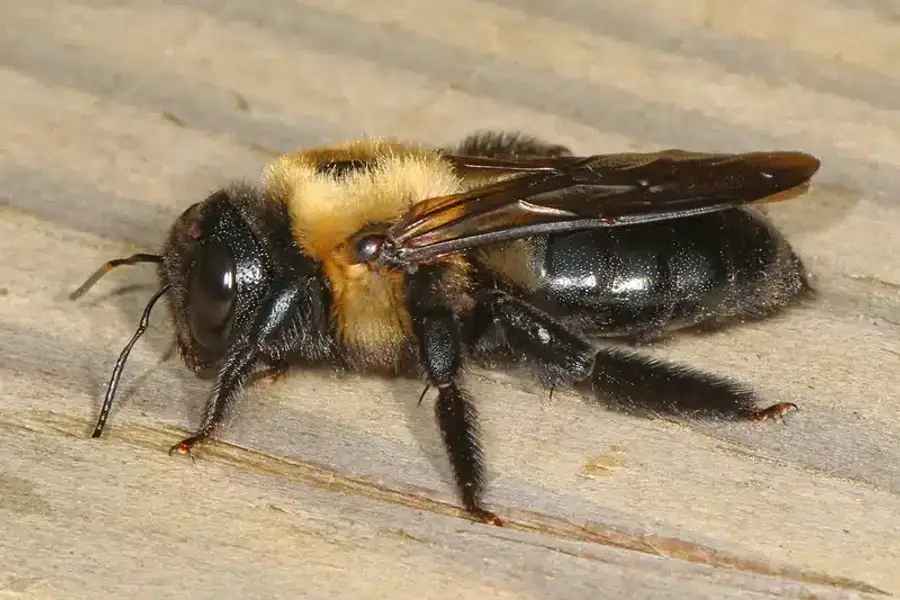
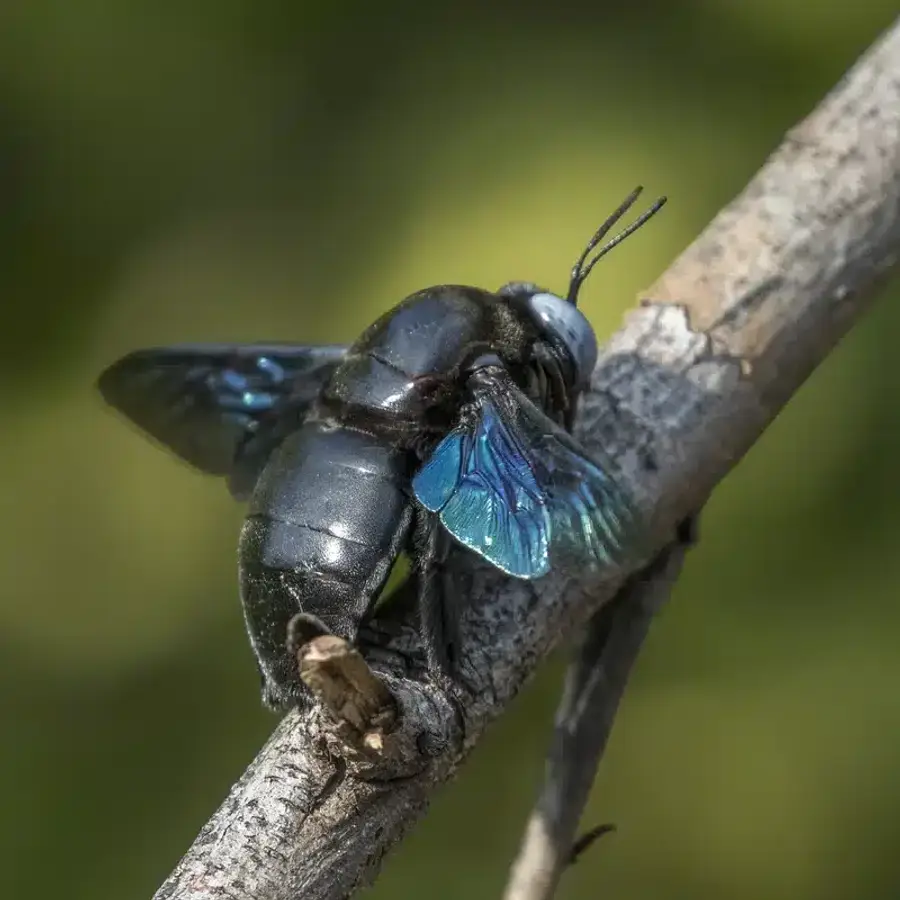
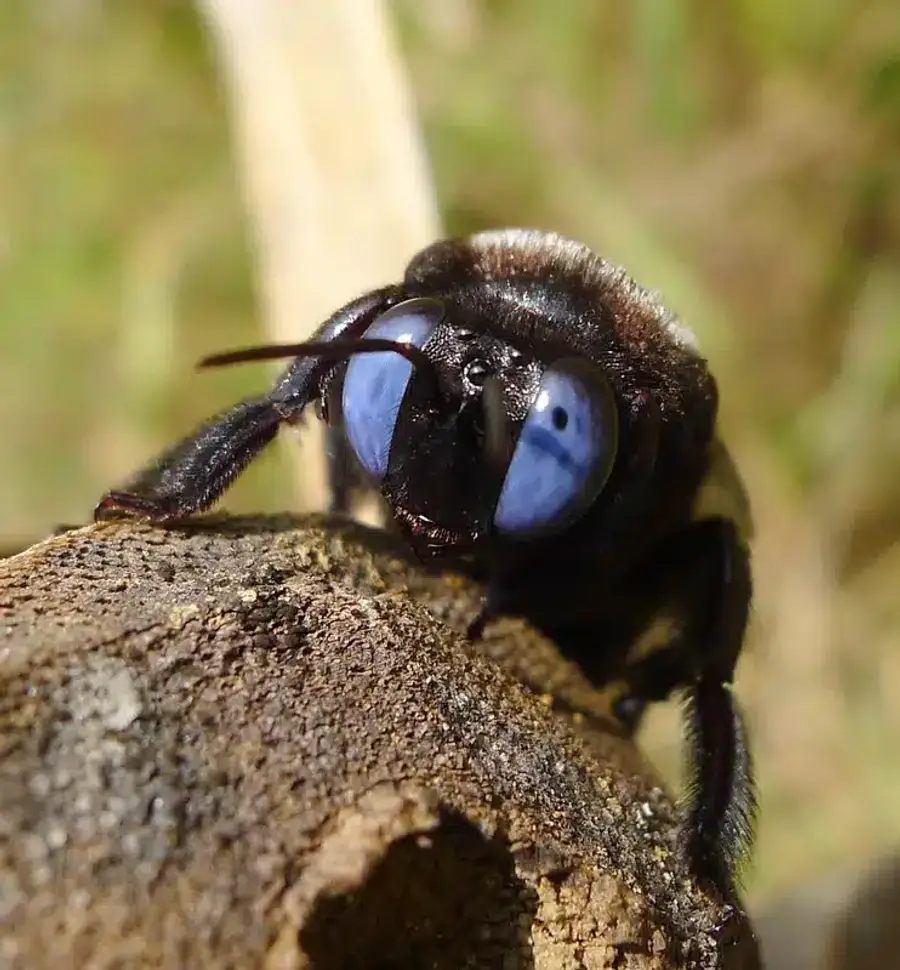

Understanding carpenter bee timing helps determine how to get rid of carpenter bees effectively. These insects follow a predictable annual cycle:
- April-May: Overwintered adults emerge, mate, and search for nesting sites
- May-June: Females excavate galleries and provision 6-10 brood cells with pollen
- July: Larvae develop inside sealed chambers while parents die
- Late August-September: New adults emerge and prepare for winter
- October-March: Bees overwinter inside old tunnels
Gallery Construction and Nest Architecture
Female carpenter bees create nearly perfect 12-13 mm entrance holes drilled across wood grain. After boring the initial entrance, they turn 90 degrees and tunnel 10-15 cm along the grain. Reused galleries can extend up to 3 meters after years of expansion.
These bees prefer weathered, unpainted softwoods like pine, cedar, cypress, and redwood. Painted surfaces and hardwoods rarely face attacks.
Damage Carpenter Bees Cause to Your Home
Primary Structural Problems
Multiple tunnels weaken critical structural elements including fascia boards, deck joists, fence posts, and log home timbers. While a single gallery poses minimal risk, repeated annual use creates serious structural concerns.
Additionally, carpenter bee damage often resembles patterns seen with other wood-destroying pests. Carpenter ants with wings and termites create different damage signatures, making proper identification crucial.
Secondary Damage from Moisture and Predators
Entrance holes allow moisture intrusion, leading to fungal growth and wood staining. The bees’ fecal deposits create fan-shaped yellow stains below holes.
Woodpeckers compound the problem by enlarging galleries while hunting carpenter bee larvae. This predatory behavior can cause more visible damage than the original bee activity.
Risk Factors for Carpenter Bee Infestations
Certain conditions make properties attractive to nesting females. Exposed, unfinished softwood in sunny locations faces the highest risk. Pre-existing cracks, nail holes, and structural gaps provide ideal starting points.
Properties with repetitive annual infestations typically have multiple generations using the same structures. This pattern leads to extensive gallery networks that seriously compromise wood integrity.
Early Detection and Monitoring
Visual Signs of Carpenter Bee Activity
Perfect round holes measuring approximately ½ inch indicate carpenter bee presence. Coarse yellow sawdust beneath these holes confirms active boring. Look for these signs on:
- Deck railings and posts
- Roof eaves and fascia boards
- Wooden siding and trim
- Fence posts and outdoor structures
Behavioral Clues Throughout the Season
Male carpenter bees hovering near wooden structures signal breeding activity in spring. You might hear audible rasping sounds as females excavate galleries. Buzz-pollination behavior on tomato and eggplant flowers also indicates their presence.
Fan-shaped fecal stains below entrance holes appear throughout the active season. Fresh sawdust in late summer means new adults are emerging.
Non-Chemical Prevention Methods
Protective Surface Treatments

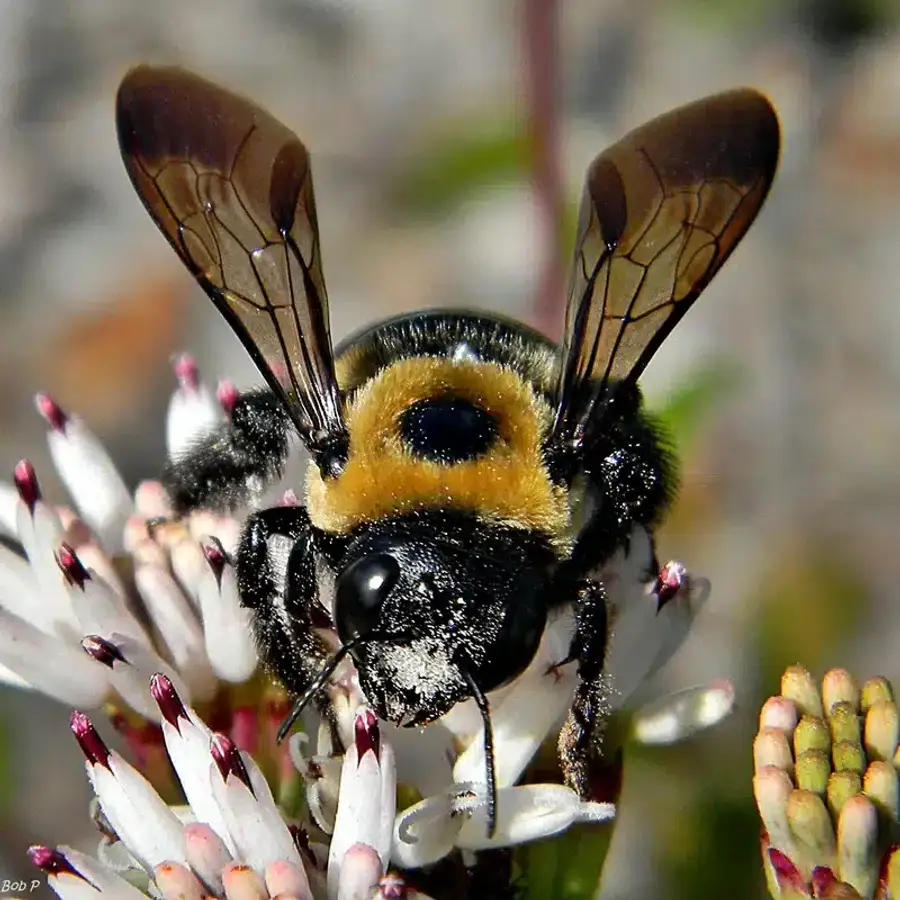
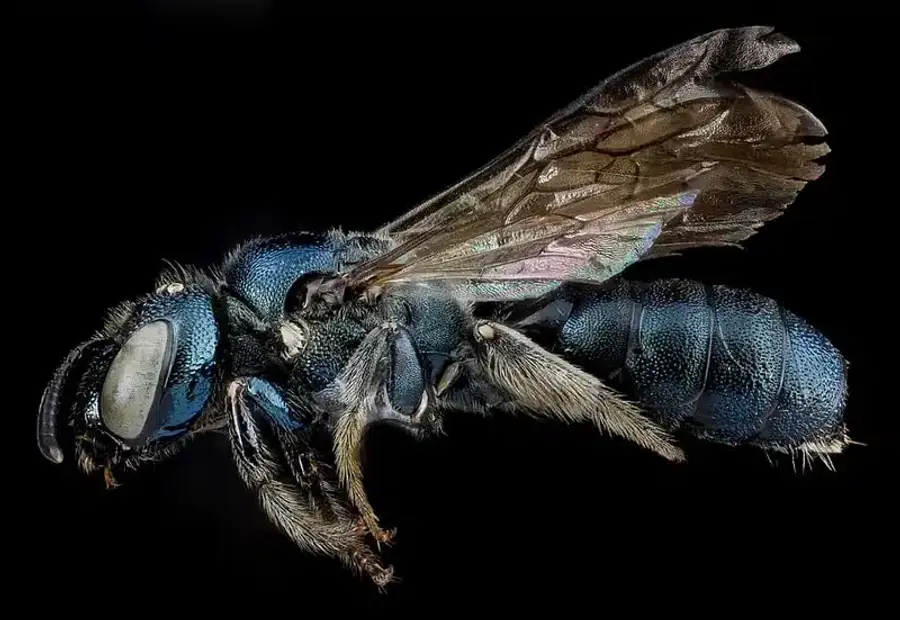
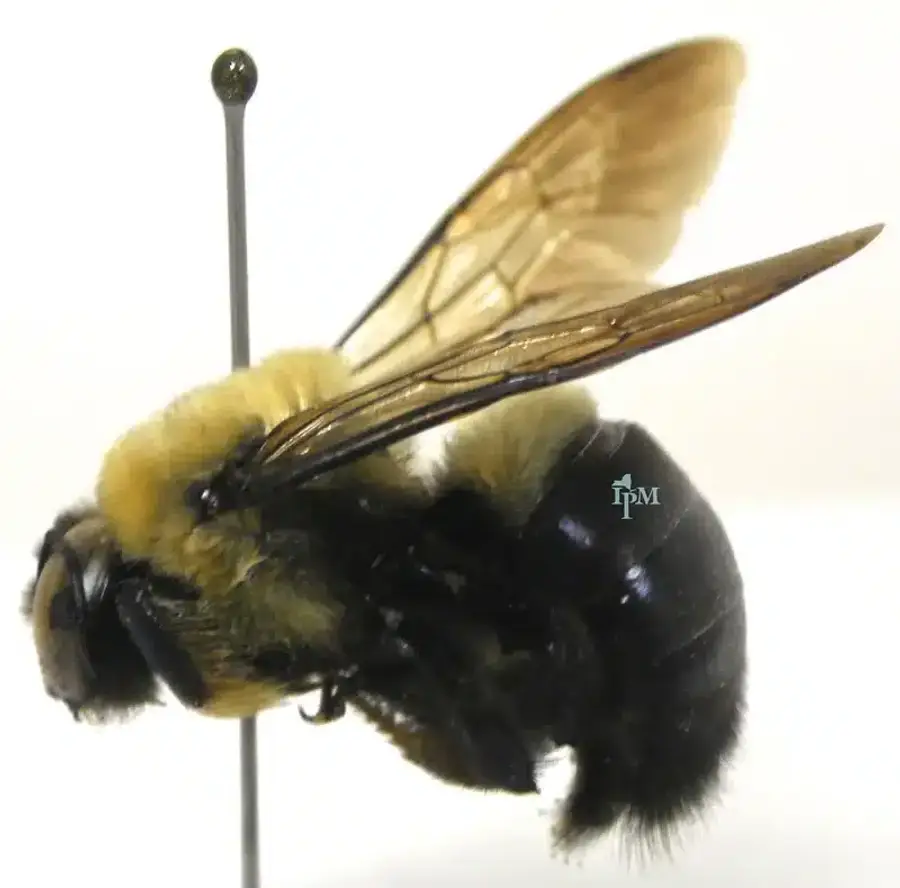
Maintaining painted or varnished surfaces provides the best long-term protection. Carpenter bees rarely attack finished wood surfaces. Repaint high-exposure trim every 3-5 years, especially on south and west-facing areas.
Fill existing cracks and nail holes with caulk or putty before applying fresh paint. This eliminates convenient starting points for gallery excavation.
Alternative Building Materials
Consider vinyl, aluminum, or PVC trim for eaves and fascia where aesthetics allow. Pressure-treated lumber and hardwoods resist carpenter bee attacks better than untreated softwoods.
For new construction in high-risk areas, these material choices eliminate future carpenter bee problems entirely.
Professional Treatment Methods to Get Rid of Carpenter Bees
Optimal Treatment Timing
Two treatment windows offer the best results. Early spring treatments in mid-April target adults before egg-laying begins. Late summer treatments in September address newly emerged adults before overwintering.
Treating during active boring periods often fails because bees abandon partially completed galleries. Professional timing maximizes treatment effectiveness.
Licensed Products and Application Techniques
Professional treatments use restricted-use products unavailable to homeowners. Pyrethroid dusts containing deltamethrin or cyfluthrin provide excellent residual control when applied correctly.
Licensed technicians use specialized bulb dusters to place materials deep into galleries. This technique differs significantly from methods used for other wood-destroying pests outlined in our guide on how to get rid of termites.
Borate and desiccant dusts offer additional control options. These materials work slower but provide longer residual protection in treated galleries.
Post-Treatment Gallery Sealing
Wait 24-48 hours after treatment before sealing entrance holes. This delay allows returning females to contact treated surfaces and carry materials throughout the gallery system.
Plug holes with wooden dowels or wood putty, then sand smooth and paint to match surrounding surfaces. Immediate sealing prevents treatment effectiveness by trapping live bees inside untreated gallery sections.
Building Design and Maintenance Strategies
Incorporate carpenter bee resistance into long-term building maintenance plans. Regular inspection of vulnerable wood surfaces allows early intervention before extensive damage occurs.
Providing alternative nesting resources away from structures benefits pollinator conservation. Untreated scrap wood placed in landscape areas can redirect nesting activity from valuable structures.
Balancing Pollination Benefits with Structural Protection
Carpenter bees serve as important native pollinators using buzz-pollination techniques. They effectively pollinate tomatoes, eggplants, and numerous wildflower species.
However, structural protection takes priority for most homeowners. Treating only areas near buildings while preserving habitat in woodlots offers a reasonable compromise.
Better Termite & Pest Control’s Approach
Our licensed technicians bring 300 years of combined experience to carpenter bee problems. Because we’re family-owned and operated, we understand the balance between effective treatment and environmental responsibility.
We’ve eliminated 9 harsh chemicals common in our industry, choosing better alternatives like Essentria, Alpine, and borate-based solutions. Each product passes through our internal research team and meets standards we’d use in our own homes.
Our carpenter bee treatments come with a 30-day warranty and unlimited callbacks until the problem resolves. Visit our service areas including pest control in Arlington and Herndon pest control for local expertise.
Treatment Costs and Investment Protection
Understanding exterminator costs helps homeowners budget for professional carpenter bee treatment. Multiple factors affect pricing including infestation severity, structure size, and access difficulty.
Early intervention typically costs less than addressing extensive gallery networks. Our comprehensive pest control cost guide outlines investment considerations for various treatment approaches.
Professional treatment protects your property investment while providing warranty coverage for peace of mind. DIY approaches often fail due to improper timing and limited product access.
Related Wood-Damaging Pests
Carpenter bee damage patterns differ from other wood-destroying insects. Carpenter ants with wings create galleries in already-damaged wood, while carpenter bees bore into sound timber.
Termite damage appears as hollow channels running with wood grain. Carpenter bee galleries run perpendicular to grain direction with visible entrance holes.
Proper identification ensures appropriate treatment methods. Each pest requires specific approaches for effective control.
Frequently Asked Questions about How to Get Rid of Carpenter Bees
What attracts carpenter bees to my property?
+
Carpenter bees prefer unfinished, weathered softwood in sunny locations. Existing cracks, nail holes, and unpainted surfaces provide ideal nesting opportunities. Properties with previous infestations often see repeated activity as new generations reuse established galleries.
Do carpenter bees sting and pose risks to humans?
+
Male carpenter bees hover aggressively but cannot sting. Females possess stingers but only use them when handled directly. Unlike [bumble bees that may sting multiple times](/do-bumble-bees-die-when-they-sting/), carpenter bee defensive behavior focuses on territorial displays rather than actual attacks.
Can I eliminate carpenter bees using DIY methods?
+
Homeowner treatments often fail due to improper timing and limited product access. Professional-grade dusts and application equipment provide superior results. Licensed technicians understand gallery architecture and treatment timing essential for effective control.
When should I schedule professional carpenter bee treatment?
+
Two optimal treatment windows exist: mid-April before egg-laying begins, and September after new adults emerge. Treating during active boring periods typically fails as bees abandon disturbed galleries. Professional timing maximizes treatment effectiveness.
How long does professional carpenter bee treatment require?
+
Most treatments complete within 1-2 hours including gallery sealing. Treatment duration depends on infestation severity, structure size, and access requirements. Follow-up inspections ensure complete elimination and verify sealed galleries remain intact.
Why choose professional carpenter bee treatment over DIY approaches?
+
Licensed professionals access restricted-use products unavailable to homeowners. Proper application techniques, optimal timing, and warranty coverage provide superior value. Our treatments include 30-day warranties and unlimited callbacks until problems resolve completely.
Will carpenter bee treatment harm beneficial pollinators?
+
Our targeted approach treats only structural threat areas while preserving beneficial pollinator habitat. We recommend maintaining untreated wood away from structures to support carpenter bee ecological roles. Treatment focuses on protecting buildings rather than eliminating all carpenter bees from properties.
How can I prevent future carpenter bee infestations?
+
Regular painting and surface maintenance provide the best long-term protection. Fill cracks and holes before repainting, especially on sun-exposed surfaces. Consider alternative materials like vinyl or aluminum trim for high-risk areas during renovations.
With five years of hands-on experience in the pest control industry, George Schulz is a registered technician with the Virginia Pest Management Association and a proud third-generation professional in a family business that's been protecting homes for over 57 years. He manages and trains a team of service pros while also leading internal research efforts—recently spearheading a deep-dive review of thousands of documents on pest control materials to hand-pick the most kid and pet friendly, most effective solutions tailored specifically for homes in the DC metro area.
